I repeated the three-step mantra while untangling myself from a mess of shooting line. Years ago, one of my fishing buddies told me Spey casting was a simple, three-step process. His description was the mantra I repeated, but I was starting to doubt my memory since I’d yet to throw a decent cast.
Earlier, before heading to the river, I’d called my friend Brett to see if he wanted to tag along.
“I’m trying out that trout Spey stuff,” I said. “It should be a good time.”
“I can’t today, but let me know how it goes,” he said.
“I will,” I said. “I’m thinking it’ll go fine. It doesn’t look that hard. It’s basically just a giant roll cast.”
Now those words haunted me. For the last hour I’d tried that “giant roll cast” to no avail. I was beginning to suspect I’d been more than a little arrogant in my original assumption. Clearly there was an aspect of Spey casting I wasn’t aware of, a foundational element I lacked. My best cast of the day made it about 30 feet before it fell limply to the water’s surface, looking as defeated as I felt, as though the line itself was disappointed.
Discouraged and humbled, I reeled in my line and left for home. I knew I needed help, but where to get it was the question. I live in Wyoming, which is hardly a hotbed for Spey fishing. This begged the question: why was I trying to Spey cast, anyway? Wouldn’t a 7-weight and a sink-tip be more than adequate for my Western-sized waters?
The seed of trout Spey was planted during my first drive to my current home. The only way in and out of this particular part of Wyoming is a road that follows a river as it winds through a canyon. The river tumbles through tight, boulder-strewn stretches, then relaxes into long, sweeping runs that certainly hold trout. But the banks are steep, and the water is too deep to wade out more than a few feet, depriving one of the room for long overhead casts. A Spey rod seemed like the logical way to cover that water.
That seed grew during my first Wyoming winter. This river is only an hour from my house, and I was going stir-crazy amidst a record cold snap. One Saturday, the temps projected to be in the low 20s — a big jump from the week of sub-zero highs we’d had — so I bundled up and went fishing. It was 14 and windy when I got to the river. I was working one of the few seams next to the bank, drifting a nymph rig through the softer water. My guides iced up every cast, and I was ready to call it when my indicator dipped. I set the hook into a solid fish, but it wasn’t until I had the trout in my net that I realized I’d lucked into a 23-inch brown.
After catching that fish, almost by accident, I reckoned the river had more trophies to give up. All the best water, though, looked to be out of reach.
After a few failed attempts to coax a few Spey-capable friends into showing me the ropes of two-handed casting, I turned to this generation’s philosopher-teacher-sage: YouTube.
It was as though the veil was lifted from my eyes. I saw the world in a whole new light — a world of sustained anchors, D-loops, level tips, and light grips. My three-step mantra was woefully incomplete, which explained why I couldn’t Spey cast to save my life. I wondered if perhaps it was my fishing buddy, not my memory, that had failed me.
Armed with this new knowledge, I took off to the river at my next opportunity. It was a warm evening, especially for late November. Clouds of tricos undulated just above the surface, and a few eager trout showed their noses. Under any other circumstances I’d have put the Spey rod away and rigged up for dries. But I had something to prove.
I walked into the water and felt much like I did as a teenager growing up in Utah, learning to fly fish on the Provo River. Catching fish in those days was a bonus, not an expectation. Instead I spent most of my time just trying to get my flies where I wanted them.
Establish an anchor. Position my fly line. Swing the rod. Create a well-formed D-loop. Keep the tip level. Drive the butt into my hip and keep the tip high. Aim for the opposite bank.
My new mantra was longer, but far more mechanically sound. My first cast rocketed across the main current, plopping my streamer in the soft seam I’d been eyeing for weeks but had yet to drift flies through. My rod tip followed the fly as it swung through the run, and the unexpected happened.
I felt a tug. A sharp jerk, actually, that yanked the slack line from my left hand.
The fish peeled line as it turned and swam downstream. I cranked down my drag, lifted the rod tip, and held on. I wasn’t sure if I needed to fight fish differently with a big rod. I hadn’t made it that far in the YouTube videos.
The fish gave one good run — as most of them do — before I wrangled it into the net. It was an 18-inch rainbow. Not another 23-inch brown, but bigger than most of the trout in these parts of Wyoming. I let it go, wiped my hands on my waders, and stared at the river. My first good cast with a two-hand rod put a nice trout in the net. I knew they all wouldn’t be that successful, but it was hard to not feel proud of myself, even if I suspected I’d done everything correctly largely through dumb luck.

I stepped and swung my way through the rest of the evening without another fish to show for it (the first cast curse is all too real). I felt like I’d accomplished something, which I suppose I had. I also felt like I had another arrow in my quiver for fishing not only this river, but dozens of others.
I threw the trout Spey rod a few more times that fall, on other rivers, swinging through runs without much success. Obviously I have more to learn, especially about presentation and fly selections, but I fully expect to keep honing my meager trout Spey skills. It feels like an underutilized skill, especially in my circles here in the Rocky Mountain West. Some of my favorite larger tailwaters — the Green comes immediately to mind — feel like they’d be perfect for trout Spey.
I also think trout Spey has more staying power in my personal arsenal than, say, Euro-nymphing or tenkara. I’ve tried both of those methods in recent years, but I didn’t fall in love with them the way some anglers have. Euro-nymphing is effective, but in a tactical, almost surgical way. Where Euro eliminates the mysticism of casting fly line, Spey casting centers it. It shouldn’t be possible to turn a mess made of sink tips, shooting heads, and running line into graceful loops, but a Spey rod and proper mechanics make the magic happen. That alone is enough to keep me coming back.




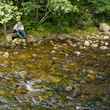


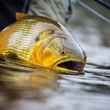




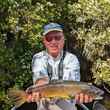




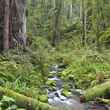



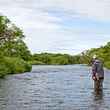
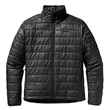



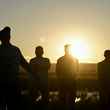
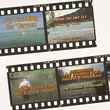



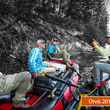
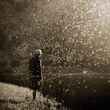
Comments